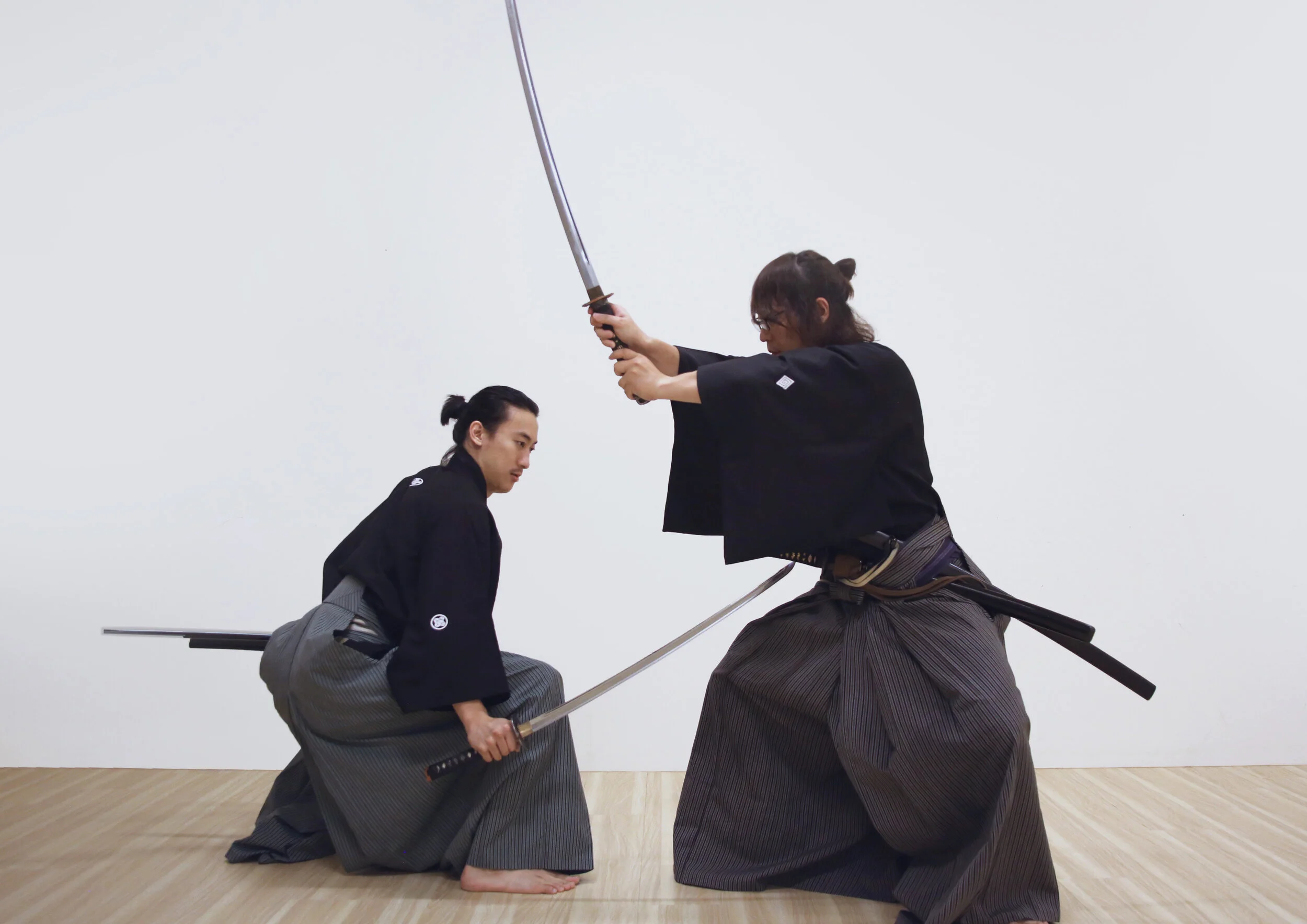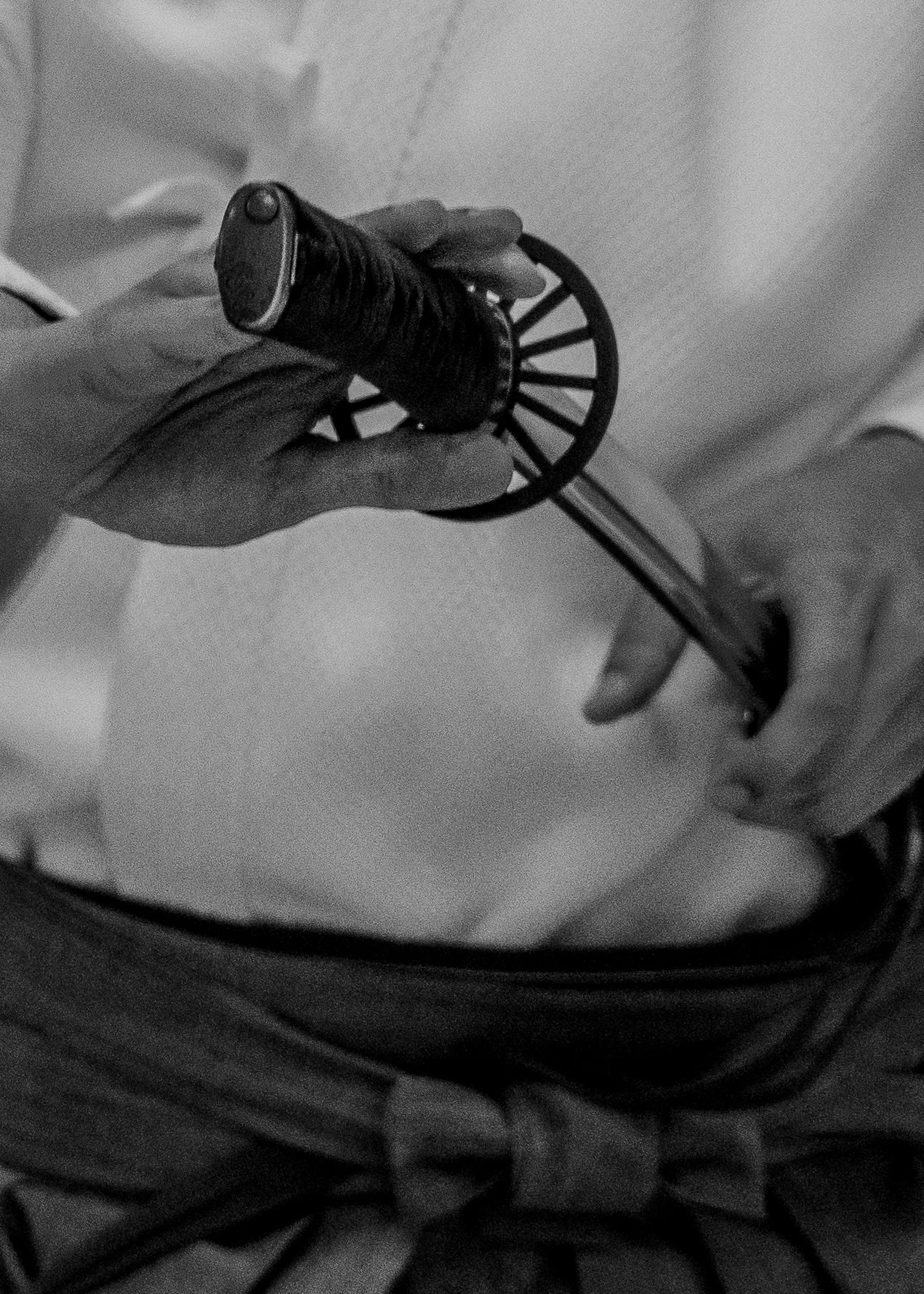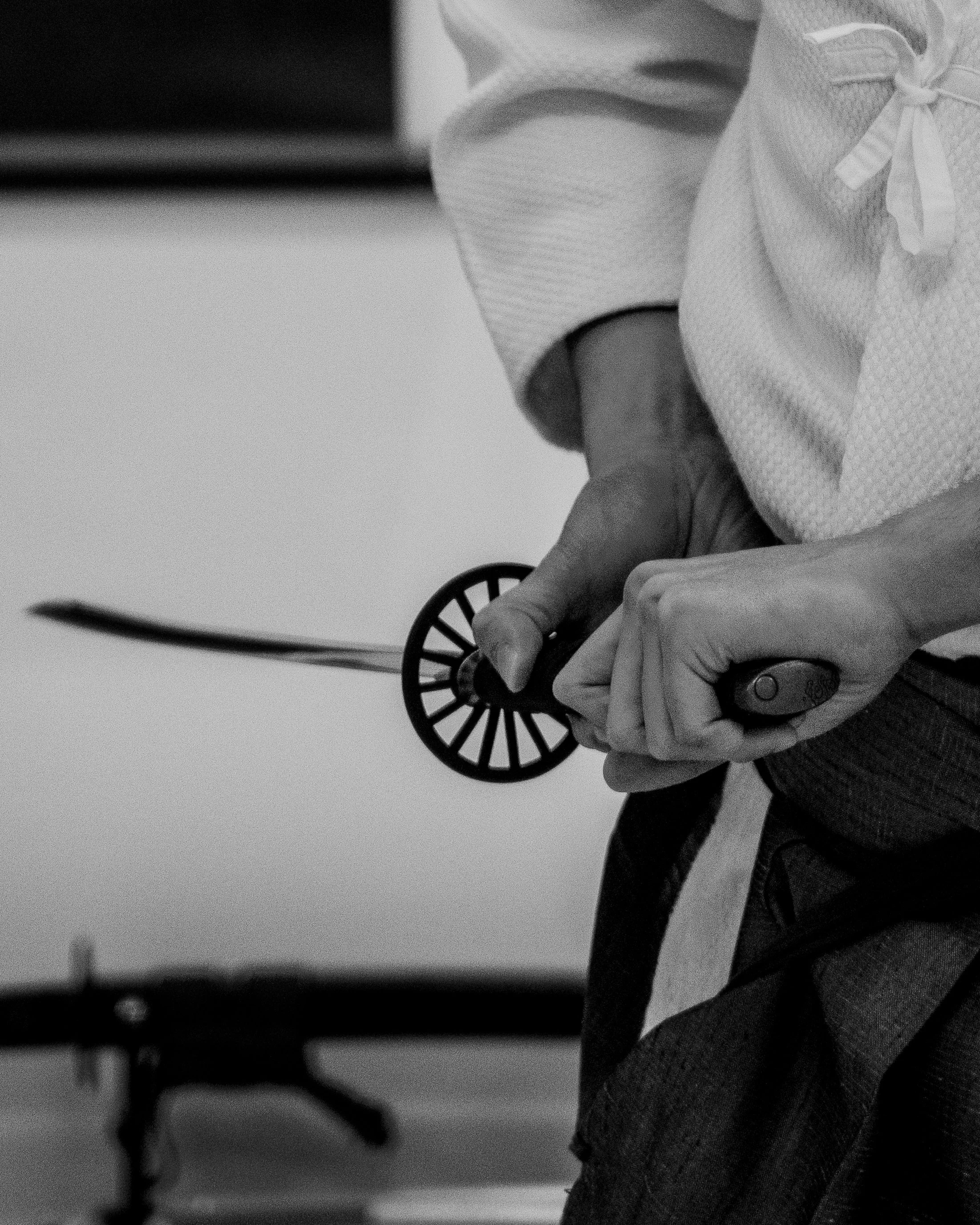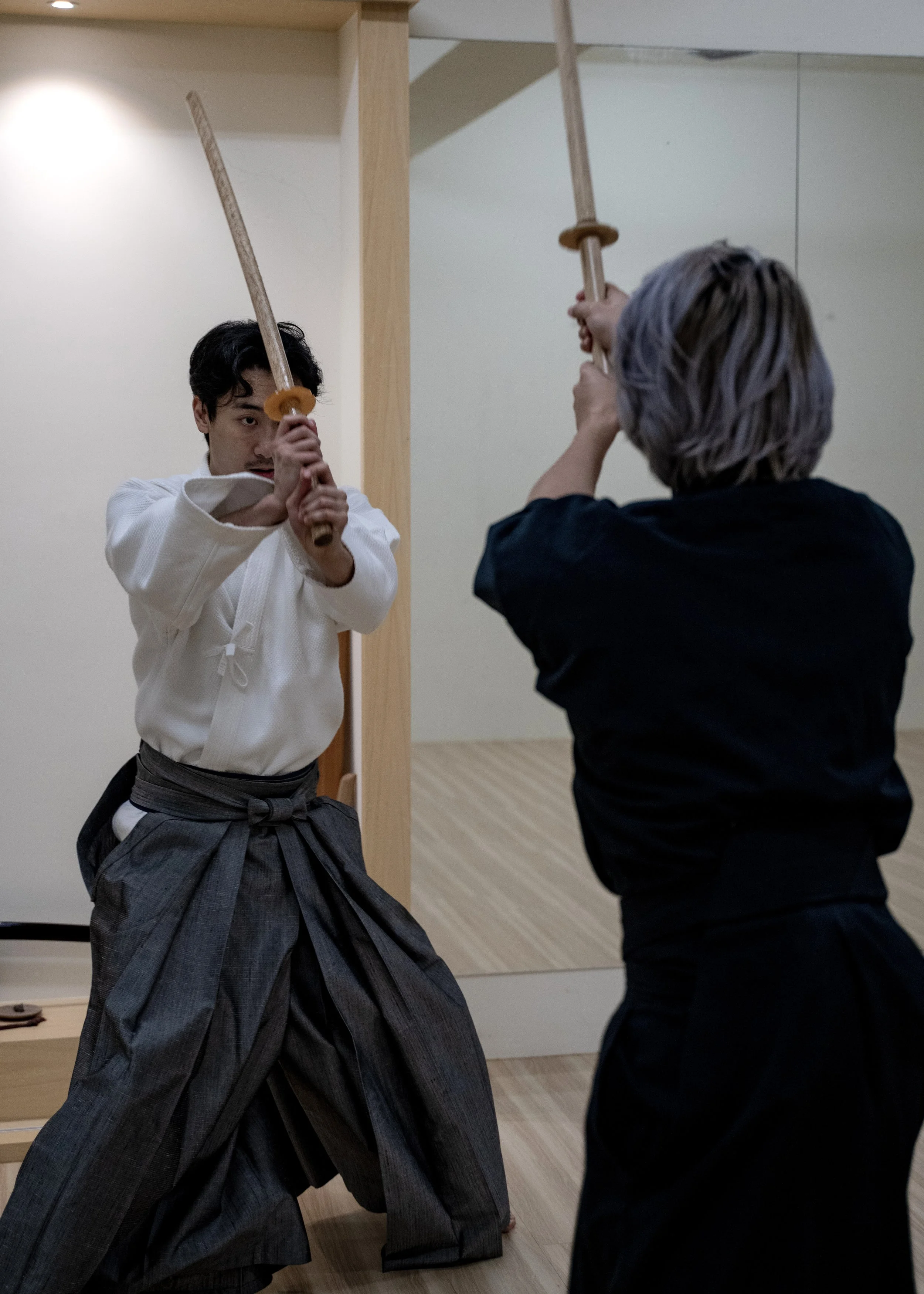






About Kobudo
About Kobudo
Ryushin Shouchi Ryu
Written by: Frank Nieves, M.A.
Translated into Japanese by: Nakaya Sumie
Edited by: Yahagi Kunikazu, Kawabata Terutaka & William Scott Wilson
Ryushin Shouchi Ryu (柳心照智流) is a school of kobudo (ancient martial arts) specializing in iaijutsu (quick-draw sword art), founded by Kawabata Terutaka, and is composed of over 60 kata (prearranged solo forms) and iai kumitachi (partnered bokken training). The current headmaster of Ryushin Shouchi Ryu is Yahagi Kunikazu.
History
In 2006, Kawabata Terutaka established Ryushin Jigen Ryu, a system of kobudo specializing in iaijutsu, composed of over 60 kata and a series of iai kumitachi. The origins of the iaijutsu kata can be traced back to the Japanese swordsmanship schools of Katori and Kashima, which derived their techniques from battlefield experience, and they have been passed down from master to student for over 500 years. According to Kawabata, the kata preserved in Ryushin Shouchi Ryu are the accumulation of the wisdom, invention, and intents of masters who lived hundreds of years ago. Kawabata has endeavored rigorously to preserve the integrity of these kata, which bring to life the way in which samurai fought during the Sengoku and Bakumatsu periods.
On the 1st of January in 2008, Kawabata relinquished his position to his senior student, Yahagi Kunikazu.
In 2011, to clarify the purpose of the school and dojo in cultivating the mind and conditioning the body through rigorous training, the original name of the school, Ryushin Jigen Ryu, was changed to Ryushin Shouchi Ryu.
Today, Ryushin Shouchi Ryu is practiced across the globe with several dojos in the United States, Canada, Europe, and Japan. Every year, Yahagi makes official trips to these various locations to conduct seminars.
Philosophy
The philosophy of Ryushin Shouchi Ryu parallels that of most modern forms of budo, (i.e. kendo, judo, and aikido) and entails cultivating the mind and conditioning the body through rigorous training for the purpose of improving the self rather than killing an enemy. This concept is more commonly known as fudoshin (immovable mind), which refers to a state of psychological and spiritual equanimity. Based on this reasoning, the name Ryushin Shouchi Ryu was selected by the founder, Kawabata Terutaka. Ryushin means “Mind or Heart of the Willow tree,” and invokes the image of a tree that does not lose its leaves even in winter; while Shouchi can be translated as “shining wisdom.” Together, these characters convey the sense of “establishing unmovable wisdom in the everyday world by means of a strong yet flexible body and spirit.”

About the Founder
About the Founder
Terutaka Kawabata
Kawabata Terutaka was born in Tokyo in 1940. His interest in Japanese swordsmanship began during his early childhood, when his grandfather gave him a sword he had purchased in San Francisco. Kawabata began his swordsmanship training in his early twenties at the Sogo Budo Shobukan, which was founded in 1963 by his father and was under the guidance of Ueno Yasuyuki Genshin (1913-1973), the headmaster of the Tenshinsho Jigen Ryu at the time. Tenshinsho Jigen Ryu is a school of swordsmanship that originated from Katori and Kashima, and dates back to the Sengoku Jidai (Warring States Period).
Kawabata would eventually spread his knowledge of Japanese swordsmanship through the International Martial Arts Federation (IMAF) (Kokusai Budoin Kokusai Budo Renmei). Through IMAF, he was sent abroad to Europe and the United States to spread his school of swordsmanship. He successively served as director and vice-director, and as the sectional chief of the Kobudo division of IMAF. In 1975, Kawabata taught at the NRC (currently the Nihon Zaidan) dojo in Akasaka. He also trained many students at the ANA Haneda dojo and the Yokohama Municipal Fire Station. He later opened the Seiseikan dojo on the ground floor of the Sankei Indoor Sports Akabane at Akabane Minami, Kita-ku, Tokyo, in the early 2000s.
TBS television program Chikyu Roman Yomigaeru Hiken/Sengoku Kabutowari
An example of Kawabata’s proficiency as a sword master was demonstrated in 1987 when he appeared on the TBS television program Chikyu Roman Yomigaeru Hiken/Sengoku Kabutowari. In this program, Kawabata cut a gash measuring 12 cm. (nearly 4 sun) through a steel helmet called oki tenugui gata (a helmet with almost vertical sides and top plates which are extended rearwards) using a sword made by Yoshihara Yoshindo. The helmet-splitting technique had not been performed successfully since Sakakibara Kenkichi, the hanshi of the Choku Shinkage Ryu, demonstrated it before Emperor Meiji in the autumn of 1886, over 100 years earlier. It was around this time that Kawabata received the Martial Arts Meritorious Award (Budo Korosho), considered the highest honor in the world of martial arts.
In addition to his training in swordsmanship, Kawabata also specializes in the collection and study of Japanese swords and their fittings. He subsequently became an executive of the Nihon Bijutsu Token Hozon Kyokai (NBTHK) (Society for the Preservation of Japanese Swords) and is known as one of their experts. Kawabata has also contributed to the founding of the Nihonto Bunka Shinko Kyokai (Association for the Promotion of Japanese Sword Culture), an organization whose intention is to perform various activities to promote and generate public interest in Japanese art and culture.
Currently, Kawabata serves as the head of the Seiseikan and advisor to the soke. He continues to play an active role in various fields, and has been awarded the Medal of Honor Yellow Ribbon (awarded to individuals who, through their diligence and perseverance while engaging in their professional activities, became public role models) and the Medal of Honor Blue Ribbon (awarded to individuals who have made significant achievements in public welfare or public service) by the Government of Japan for his contributions.

About the Headmaster
About the Headmaster
Kunikazu Yahagi
Yahagi Kunikazu, the second headmaster (soke) of Ryushin Shouchi Ryu, was born in Katsushika-ku, Tokyo, in 1948. As a child, Yahagi was inspired by his grandfather, whom he visited regularly, and who had 2 sets of antique kendo bogu (armor) on display in his home. Yahagi was introduced to kendo by his uncle at the age of 10 and commenced his kendo training in elementary school. He also trained in Judo from the age of 12, an art in which he later went on to earn the rank of 2 DAN at the Kodokan. He would continue his martial studies through his formative years, and at the age of 30, he entered the NCR dojo (now the Nihon Zaidan Building) in Akasaka, Minato-ku, Tokyo, which was then under the authority of Kawabata. After nearly 30 years of diligent training under the tutelage of Kawabata, Yahagi was licensed by the International Martial Arts Federation (IMAF) as a Kobudo Hanshi 8 DAN and later succeeded in becoming a director for IMAF. This would mark the beginning of Yahagi’s international teaching career. In 2008 Yahagi became the second headmaster of Ryushin Shouchi Ryu.
Yahagi Sensei teaching a seminar in New York
In addition to his Ryushin Shouchi Ryu training, Yahagi continues his studies in Kendo and currently holds the rank of Kyoshi 7 DAN from the All Japan Kendo Federation. He believes that through the diligent training of Ryushin Shouchi Ryu, one can develop the true spirit and mindset from times past that are necessary for the proper practice of kata.

About the Chief Instructor
About the Chief Instructor
Ed Lin
Chief Instructor (4th Dan, Renshi, Shidoin)
Ed joined New York Budokai in 2013, training under instructors Phil Ortiz (6th Dan, Instructor), Valiant Yeung (5th Dan, Renshi, Instructor), and Mitchell Ratchik (5th Dan, Renshi, Instructor). In February 2017, Ed was awarded the rank of Sandan under the examination of Ryushin Shouchi Ryu founder Terutaka Kawabata and Shihan Kunikazu Yahagi, and subsequently established Taipei Budokai. In 2021, he received his Yondan rank under the supervision of Yahagi Shihan, followed by the Renshi title in 2023. In March 2025, Ed obtained his official instructor certification and was granted the official martial name “Ryuchi” (りゅうち).
Ed is dedicated to fostering a rigorous and challenging training environment while ensuring students feel safe and enjoy the process. He emphasizes that, as taught in the philosophy of Ryushin Shouchi Ryu, training is not only a physical endeavor but also a form of mental cultivation—one that influences life beyond the dojo.
Every spring, Yahagi Sensei visits Taiwan to lead an intensive seminar, offering students in-depth instruction and opportunities for exchange. In addition, members of Taipei Budokai regularly travel to Japan to train with Yahagi Sensei, continuing their technical growth and strengthening ties with the honbu dojo.

About the Assistant Instructors
About the Assistant Instructors
Roberts Huang
Roberts Huang (3th Dan, Jun-Shidoin)
Roberts Huang formally began training in the classical martial art Ryushin Shouchi Ryu in 2018 under the instruction of Ed Lin, Chief Instructor of Taipei Budokai. He has traveled to Japan multiple times to train directly under Shihan Kunikazu Yahagi. In 2025, he was awarded the rank of Sandan and the title of Assistant Instructor under Yahagi Shihan’s examination. He also received the official martial name “Ryukoku” (りゅうこく) from the founding headmaster, Terutaka Kawabata.
Currently serving as the Director of the Taiwan Office of the Society for the Promotion of Japanese Sword Culture, Roberts Huang is dedicated to advancing the study and cultural exchange of Japanese samurai traditions and sword craftsmanship. He has organized and hosted numerous events related to Japanese sword culture, including the “Beauty of the Blade” exhibition at the Beitou Hot Springs Museum co-hosted with the Japan–Taiwan Exchange Association, the “Soul of the Samurai” lecture at Taoyuan Shrine, and “The Sakura Banquet: Japanese Arts Festival,” all promoting traditional Japanese martial arts and sword culture.
In 2024, Roberts facilitated the signing of a cultural exchange and industry-academic cooperation memorandum between the Society for the Promotion of Japanese Sword Culture and Soochow University, fostering academic and cultural collaboration and advancing research and development of Japanese sword craftsmanship and samurai culture in Taiwan. This partnership established a long-term foundation for cooperation and opened a new chapter in the education and promotion of Japanese sword culture in Taiwan.
Roberts has long maintained close ties with prominent figures in the Japanese martial arts and swordsmithing communities, studying and collaborating with renowned masters such as Terutaka Kawabata, Yoshio Watanabe, Kuniie Yoshihara, and Yoshindo Yoshihara. In addition to his dedication to training in classical iaijutsu, he actively promotes Japanese sword craftsmanship and samurai culture through his YouTube channel R’s Midnight Dojo.
He believes that martial arts training is not merely the honing of technique but also the transmission of culture and history. Through lectures, seminars, and demonstrations, he hopes to help more people understand the spirit of Bushido and the artistic value of Japanese swords.

About the Assistant Instructors
About the Assistant Instructors
Zi-Chi Yeh
Zi-Chi Yeh (3rd Dan, Jun-Shidoin)
Zi-Chi Yeh began training in Ryushin Shouchi Ryu in 2018 with Taipei Budokai under the instruction of Chief Instructor Ed Lin. She has made several trips to Japan for intensive training under the direct guidance of Shuseki Shihan Kunikazu Yahagi. In 2025, she was awarded the rank of Sandan and the title of Assistant Instructor under Yahagi Shihan’s examination, and received the official martial name “Yūryū” (ゆうりゅう) from the founding headmaster, Terutaka Kawabata.
Zi-Chi currently serves as the Cultural Outreach and Operations Manager at the Taiwan Office of the Society for the Promotion of Japanese Sword Culture. Working alongside Roberts Huang, she is committed to connecting with local communities and resources to support the education and cultural development of Japanese samurai traditions and sword craftsmanship in Taiwan.
During her training trips to Japan, Zi-Chi has built relationships and collaborated with masters in the Japanese martial arts and swordsmithing communities, including Terutaka Kawabata, Yoshio Watanabe, and Yoshindo Yoshihara. She maintains strong ties with the Japanese side while continually seeking personal growth and refinement in her practice.
Zi-Chi has played a key role in organizing several events related to Japanese sword culture, including the 2025 “Beauty of the Blade” exhibition co-hosted with the Japan–Taiwan Exchange Association at the Beitou Hot Springs Museum, the 2024 academic-industry partnership between the Society for the Promotion of Japanese Sword Culture and Soochow University, and the 2021 “The Sakura Banquet: Japanese Arts Festival” performance and exhibition.








